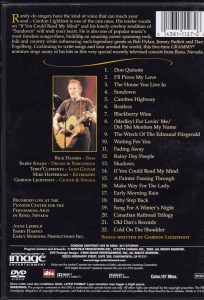It amazes me that it took this long for somebody–in this case, 2 Canadian women filmmakers–to finally acknowledge and pay tribute to famous, popular folk singer Gordon Lightfoot and his life, performing career, and major body of work.
They have done an excellent job in bringing to fans’ attention many unknown and missing parts as well as forgotten moments from Lightfoot’s life and performances. The viewer sees Lightfoot as a child in his hometown of Orillia, as a performer starting out in CBC’s Country Hoedown, as part of a duo, and as part of a big band orchestra singing and playing drums.
Lightfoot is shown in ’60s Toronto playing at the Riverboat and in other venues such as Massey Hall over 6 decades. Likewise, there is an eclectic mix of performance clips from early television shows, U.S. shows, and off-stage interviews and ad-libbed behaviors.
The documentary approximates a chronological order, but is not afraid to dip back into the past for key and telling episodes such as his relationships with women. It also memorably begins with an 80-ish Lightfoot (looking in rough shape, but more than mentally intact) and his present wife watching him sing “For Lovin’ Me” on a big screen tv, then him ordering it to be turned off because of its blatant ’60s chauvinism.
This is a film, though, that contextualizes everything about him including via comments by old performer-friends Bob Dylan, Ian and Sylvia, Ronnie Hawkins, and many others–all showing the ravages of time. This could very well be the last time we see Lightfoot and many of these people, some of whom are already dead like Elvis, who covered “Early Morning Rain”. (In passing, we hear of Frank Sinatra’s failed recording session with trying to do “If You Could Read My Mind”–his verdict: “too long”).
All the classic songs are included with highlighted segments on “Early Morning Rain”, “Sundown”, “The Canadian Railroad Trilogy”, “Song for a Winter’s Night”, “Don Quixote”, “The Circle Is Small”, and “The Wreck of the Edmund Fitzgerald”. There are even about 4 rarities including a live “Spin, Spin, Spin”, now a collectors’ coveted 45 rpm. Notable other songs excerpted: “For Lovin’ Me” (duet with Johnny Cash) ,”Steel Rail Blues”, “Beautiful”, “Pussywillows, Cat-Tails”, “Boss Man”, “Did She Mention My Name”, “Cotton Jenny” (with Anne Murray), and “Shadows”.
There are also segments on the many artists who covered Lightfoot’s material from Neil Young to Glen Campbell. When you sell 10 million records of your own, your songs get well-known and covered by many other notable performers, Sinatra excepted.
Finally, I have to comment on two of the strong suits of this tribute. 1) Lightfoot is presented, warts and all (including as a perfectionist, recovered alcoholic, and womanizer) and 2) he is shown performing from pre-school age to 80. The directors have skillfully dipped into different shows from T.O. days to Massey Hall shows to television and live-stage performances. The viewer sees Lightfoot at a wide range of ages, not just in chronological order. This effect underlines the essential Lightfoot, regardless of age or contexts, in the clips.
Lightfoot’s own appraisal is that he was gifted and knows it. There is more confident pride in that appraisal than bragging. He considers himself to be lucky to be a survivor and still performing (as of 2020, too). He has enjoyed and still enjoys his life very much.
This documentary is a must for any Lightfoot fans, major ’60s folk fans, songwriter fans, and Canadian artists fans. Highly recommended and very entertaining. Amazing how much directors Martha Kehoe and Joan Tosoni were able to cram into this memorable 1 1/2 hrs. And a most lucky thing to have filmed this all before he and notable others have passed and gone before we realize it. Quite a worthy, deserving salute to one of the last Canadian musical legends.
ps/ the only other Lightfoot DVD– in performance, 2000:
my signed Lightfoot photo from the ’60s:




